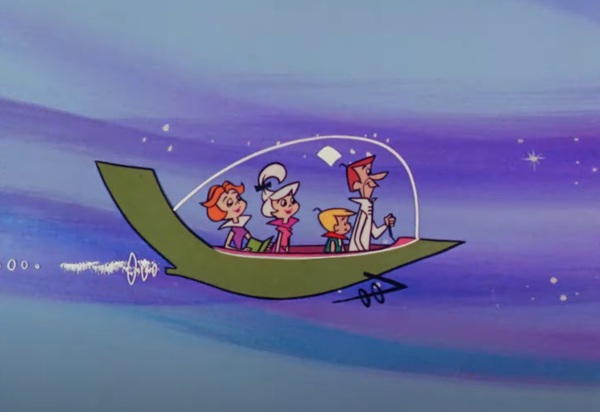
–>
September 28, 2022
The human mind has a specific talent for extrapolation. That is, it has the propensity to project current events and technologies along a straight timeline with a constant slope into the future, predicting what the future will look like, and when it will occur.
‘); googletag.cmd.push(function () { googletag.display(‘div-gpt-ad-1609268089992-0’); }); }
Unfortunately, this talent is frequently vastly inaccurate. History and human events rarely follow a straight line. Some technological advancements occur on an exponential or geometric curve, while others flatline.
In the 1960’s, it was widely predicted that we would all be flying around in jetpacks and flying cars like the Jetsons by 1980.

YouTube screengrab
The 1968 movie 2001: A Space Odyssey had us flying to Jupiter by 2001 in an advanced spacecraft controlled by an AI computer.
‘); googletag.cmd.push(function () { googletag.display(‘div-gpt-ad-1609270365559-0’); }); }
On the other hand, the original Star Trek (1965 – 1969) , while taking place in the 23rd century had them using crude flip-phone communicators. The transporter beams were pretty cool, though. Who knows if we could ever get that technology to work?
The point is that humans continually overestimate the ability of technology to meet their inflated expectations. This is especially true when politics is part of the mix.
I have personally experienced this phenomenon many times in my line of work. I was involved with teams of businesspeople attempting to design advanced electronic business systems over the past forty years.
Over and over, the same scenarios emerged. Each team member would throw up a fantasy wish-list of impossible system operations and objectives until my head spun. No one could be dissuaded that their desires were not feasible with the current state of technology. The consultants and business system development companies would inevitably take the money and run, leaving us with products that were substandard or nonexistent.
I was a member of senior management in a division of a global corporation in the early 1980’s. Our division had a great reputation for designing and building complex electronic medical devices. One day, we were visited by several senior scientists from corporate headquarters. They wanted to know if a new product they desired was feasible.
They showed us a wooden model of a small wearable insulin pump with painted-on displays and buttons. It had tiny removable wooden memory cards that plugged into it. Today, these micro cards are common. Back then, Atari game cartridges were the smallest data chips available. They told us a development company said they could design the product and put it into production in six months.
‘); googletag.cmd.push(function () { googletag.display(‘div-gpt-ad-1609268078422-0’); }); } if (publir_show_ads) { document.write(“
I didn’t want to insult our scientists by calling them crazy, so I told them this company would need to have many employees with minds on the level of Einstein and Edison to accomplish this. Products on this scale of technology typically take at least ten years of development or more, sometimes with no result.
Of course, they didn’t listen to me, gave the development company six million dollars on a handshake, and wound up with nothing. The development company, on the other hand, did very well and grew into a major designer and manufacturer of medical products.
Let us shoot ahead to the present day. The electric vehicle (EV) craze has struck the minds of progressives as the solution to all of our climate problems. Reason and rationality are defenestrated.
You cannot tell progressive politicians that the technology for EV’s is still in its infancy. You cannot convince them that the current state of technology makes them completely impractical and unworkable on a national scale.
We are at the same point in technological history as we were in 1896, when we transitioned from “horseless carriages” powered by steam and electric motors to gasoline engines. What we see on the EV road today will in no way resemble what the technology ultimately comes up with.
If you examine the facts, you see this is true. Current technology extrapolated into a nation of more than 250 million registered vehicles on the road will result in EV chaos.
The current electric grid will need to be strengthened by the development of hundreds of new nuclear power plants. There is no political will in this country to do that, especially among those promoting EVs the hardest. Hundreds of new windmill and solar farms aren’t going to cut it and will negatively impact the environment and wildlife much more than nuclear.
Electric cable will need to be buried across perhaps hundreds of thousands of miles throughout the nation to support at least 145,000 charging stations needed to replace existing gas stations. They will be required at frequencies of at least every 100 miles of road, even across the Great Salt Lake and Mojave deserts and vast mountain ranges. The logistics behind this are staggering.
Has anyone determined the economic impact of slowing road travel across the country due to the time required to wait in line at charging stations and to adequately charge an EV? What will the impact be to crime and motorist safety in inner cities or lonely stretches of road?
Billions of giant batteries will need to be built. When do we reach peak lithium or cobalt? How much of the world will be devastated by strip mining using slave labor? Where do we store the billions of batteries when they die? The potential costs to humanity and the environment are incalculable.
Since Red China is the primary source for these batteries, as well as wind turbines and solar panels, will we become economically enslaved by our dependence on these products?
Up to 17 states are geared to follow California down the rabbit hole and ban the sales of new gasoline-powered vehicles by 2035, just twelve and-a-quarter years from now. Have they thought ahead to all of the potential costs and ramifications of this decision? No, of course not.
This is tantamount to throwing everyone off a high cliff and expecting someone to develop a parachute on the way down. You cannot force technology advancements by political edict.
Advancements will occur over time. At some point, perhaps after most of our lifetimes, practical non-gasoline engines will become a reality. They will most likely look a lot different than the visions of today’s progressives.
Solutions involving nuclear fusion or rechargeable hydrogen fuel cells may be the ultimate result. In the meantime, the technology fairy-dusters are intent on making our immediate lives miserable by imposing their unworkable fantasies.
Andrew Thomas blogs at http://darkangelpolitics.com
<!– if(page_width_onload <= 479) { document.write("
“); googletag.cmd.push(function() { googletag.display(‘div-gpt-ad-1345489840937-4’); }); } –> If you experience technical problems, please write to helpdesk@americanthinker.com
FOLLOW US ON
<!–
–>
<!– _qoptions={ qacct:”p-9bKF-NgTuSFM6″ }; ![]() –> <!—-> <!– var addthis_share = { email_template: “new_template” } –>
–> <!—-> <!– var addthis_share = { email_template: “new_template” } –>





